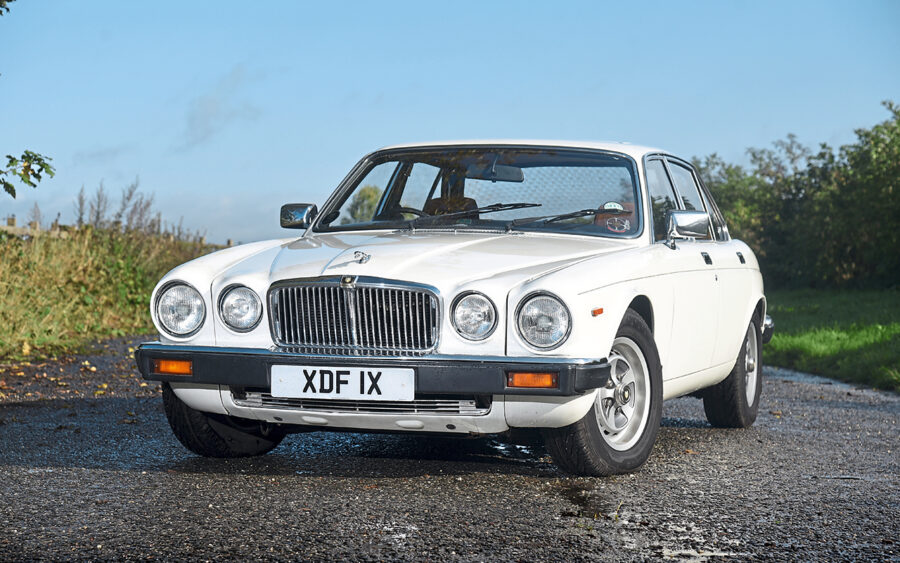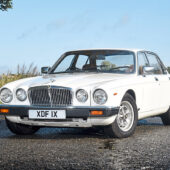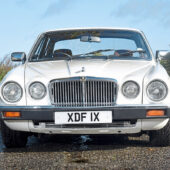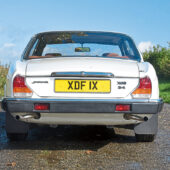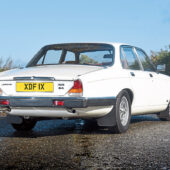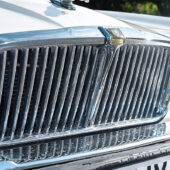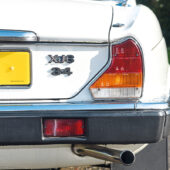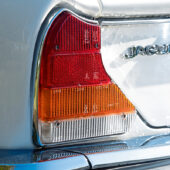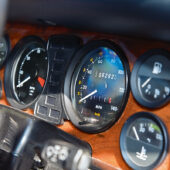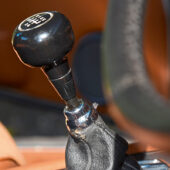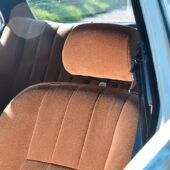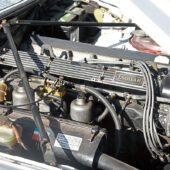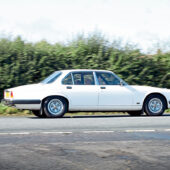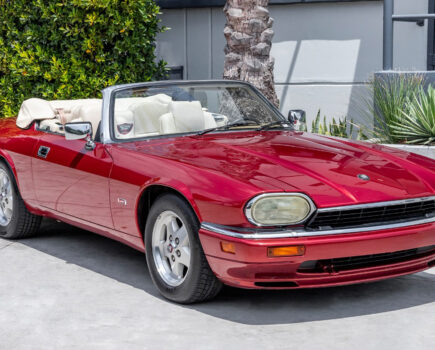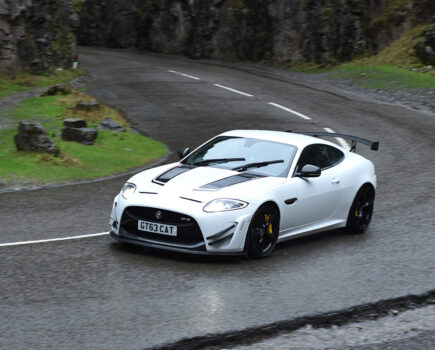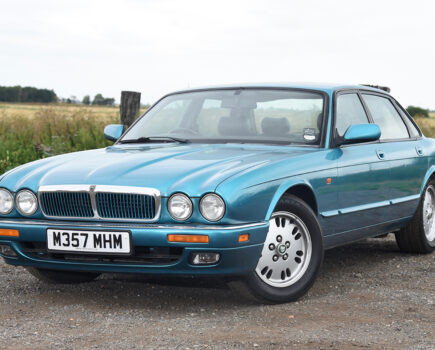Its smaller engine and cloth seats might make this XJ6 Series 3 the antithesis of most large Jaguar saloons, but as we discover it’s still a fine performer
Words and images: Paul Walton With thanks to: Classic & Sportscar Centre
Thanks to the traditionally luxurious interior and 3.4-litre XK engine of the 1950 MkVII, Jaguar’s large saloons soon earned a reputation for being both powerful and comfortable. And although their design and technology would change considerably over the next 30 years, this reputation didn’t. Even in 1979 Jaguar’s new flagship, the XJ Series 3, remained largely true to its richly appointed predecessors. As a brochure for the car from the time says, “Leather upholstery, the mark of utter luxury.”
Yet not every example of the Series 3 can be described as such since a tiny handful could even be called basic.
Once Jaguar had consolidated its complicated range of saloons in the late 1960s, reducing the 240/340, S-type, 420 and 420G to just one model – the XJ6 – it meant the new car had to meet every demand. And so from the outset as well as the 4.2-litre version of the XK straight six there was also a cheaper 2.8-litre model.
Although it produced 180bhp, the car’s performance was still gutless, taking almost 13 seconds to reach 60mph. It was probably this, together with a well-earned reputation for piston failure which explains why after over 13,000 of the 2.8-litres had been produced the engine was quietly dropped a short time before the original XJ6 gave way to the Series 2 facelift in 1973.
But Jaguar’s management always understood the importance of a smaller-engined XJ6 since it would expand both the car and the company’s range. And so in 1975 it reintroduced a familiar sized version of the XK unit, the 3.4-litre which had first seen in 1948 and discontinued 20 years later. But although Jaguar used the same 83 x 106mm bore and stroke as the original, it was in the strengthened and improved version of the 4.2’s block.

Together with twin SU HS8 carburettors, this new 3.4-litre produced 160bhp – 50bhp less than its previous guise as found in by the 340 and S-Type – and was available with either a three-speed automatic or a four-speed manual transmission.
When the XJ was refreshed for its third and final time in 1979, the 3.4 was carried over. But whereas the 4.2-litre now had fuel injection which saw its power increase from 170 to 205bhp, the 3.4 stuck with the carbs, meaning its output remained the same at 160bhp.
Although good enough for the mid-1970s, this lack of progress saw the XJ6 3.4 quickly fall behind the competition. This was Car magazine’s judgement in its May 1983 issue when it compared an XJ6 3.4 with a Mercedes-Benz 280SE whose 2.8-litre straight six produced 25bhp more.
“Once the cars are underway, the Jaguar lags consistently behind. By modern standards, its time of 11.7 sec to 60mph is not quick; hardly the stuff of which Jaguar legends are made.”
Some things had moved on though, since in 1978 Jaguar had introduced the option of a new five-speed transmission for both versions of the straight six engine. It had originally been designed by Triumph and later used across Leyland’s portfolio of brands including Rover but before it could be used by Jaguar its engineers needed to modify the unit with a stronger layshaft and better bearings to reduce noise plus design a new casing and linkage to enable it to fit the XJ.

Viewed and marketed as Jaguar’s entry saloon and only available in XJ6 trim, the 3.4 was seldom sumptuously appointed. Unlike the 4.2 model, it didn’t receive leather upholstery as standard although this could be ordered as an expensive option. The seats were instead covered in velour which was replaced by tweed in 1986.
But this came at a price since other than its economy – which by the 1980s was beginning to look poor compared to its rivals – the main raison d’etre of the XJ6 Series 3 3.4 was its relative affordability. When the car went on sale in early 1979 it cost £11,189 which although a few hundred pounds more than its Series 2 predecessor was over a grand less than its 4.2 sibling and £4k less than the XJ12.
By 1983 this had risen to £13,951 which was important since unlike the 4.2 it remained under the UK’s £14,000 company car tax bracket. The 3.4 might have been Jaguar’s entry model yet no matter the engine any XJ6 would have made a more desirable company car than a top-of-the-range Ford Granada 2.8 Ghia X or Opel Senator 3.0 both of which were similarly priced.
It was no doubt this attractiveness to the corporate market which explains why the XJ6 3.4 continued until the end of Series 3 production in 1987. As a more basic type of XJ6, it also set the standard for the entry-level version of its replacement, the 2.9-litre XJ40 which was also available with cloth trim and even plastic hubcaps. It’s not known how many of the 133,00 Series 3s produced left Browns Lane with the 3.4-litre, a manual transmission and cloth trim – but the general consensus is not many.
It might be the entry XJ6 but by looking little different from the 4.2 or V12 models it retains all the elegance of the Series 3. Thanks to the first owner specifying the optional Kent alloys over the standard steel rims, only the discreet 3.4 badge on the boot lid sets the exterior apart from the more upmarket versions.

But on first glance the interior appears more basic than the Morris Ital which would have still shared showroom space in BL dealers back in ’83. Thankfully there’s still veneer covering the dashboard which stops the cabin’s total plummet to mediocrity. Yet there’s no denying the bright orange upholstery would have given Jaguar’s more traditional clientele a massive coronary.
With this car covering a mere 65,000 miles and said to be in an original condition the velour shows remarkable little signs of wear. Considering the low values of the 3.4 over the years and the many which were scrapped when their more valued 4.2 and V12 siblings were saved, it truly is a survivor.
Forget what the critics and your own preconceptions might say – on the move, the 3.4-litre offers plenty of performance. Eager, free-revving and responsive, the engine needs little persuasion to deliver its power and it rolls along smoothly and with little encouragement. Not blisteringly fast, admittedly, but if speed is your priority then buy a much later XJR. Neither does it sound unrefined, though, and even when pushed hard remains relatively quiet.
Since the example that road tester at Car magazine was so critical of 40 years ago was fitted with an automatic, the improved performance of this one is no doubt due to the manual gearbox. Not only do the ratios suit the engine but the ability to hold the revs for longer means I can wring out a little more performance than I would with the three speed Borg Warner automatic Jaguar was using at the time. Plus it might have come from elsewhere within the Leyland empire but it’s sweet to use with surprisingly smooth and accurate changes.
Add the Series 3’s always supple ride that absorbs any roughness in the road like a sponge would with water and it makes the 3.4-litre XJ6 as pleasant to drive as those with leather seats or a larger engine.
The XJ6 3.4 might have been the entry level model but in my view it’s just as comfortable and there therefore as desirable as any of its more luxurious predecessors.

